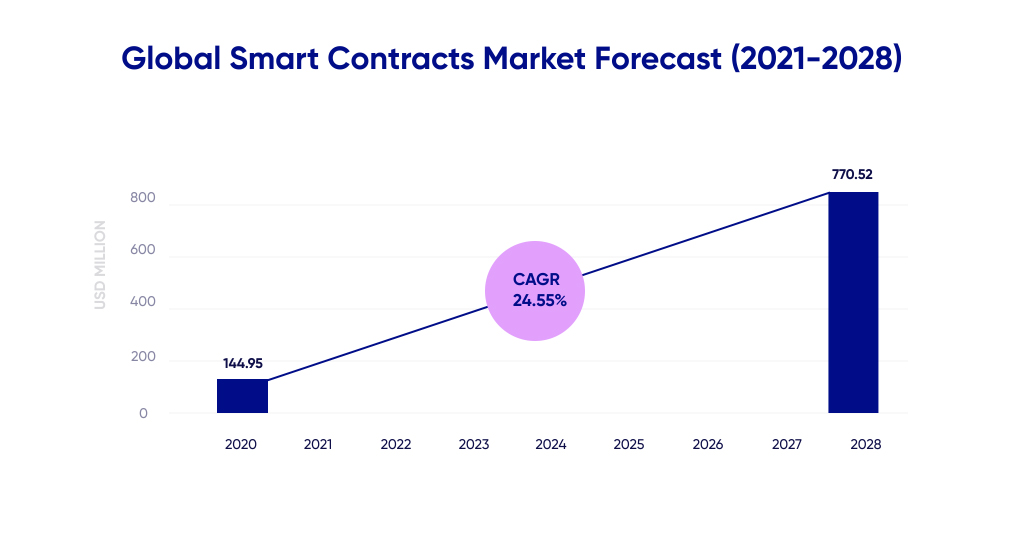Blockchain is in full force, and such concepts as Bitcoin, Ethereum, tokens, and encryption are well-known even among people who bear no relation to Fintech or IT. Business owners understand that it’s a modern alternative to goldmines, and more entrepreneurs each day are willing to know how to create a smart contract to make bank.
Long lines of code combined with many IT terms known predominantly among the tech gurus may demoralize and frustrate people willing to entrust their business success to smart contracts. For this reason, this editorial was written to interpret the nuances of smart contract development. It will be useful for anyone willing to grasp the tech fundamentals and the business futurity.
Smart Contracts: the Concept
Imagine a classic legal document that confirms a specific commitment and binds/obliges all the contractors. A smart contract does the same, yet the terms are recorded as code. The program “lives” in a chosen Blockchain and automates the accomplishment process.
Consequently, if the foreordained conditions are met, all the partakers can count on a particular immediate outcome.
Simply put, it’s the “if… then…” algorithm. Say, an insurance claim submitted as a smart contract will contain requirements (e.g., storm damage, lightning, fire, theft, etc.) that will trigger the payment. If your house was hit by lightning (the preset criteria were met), the system automatically initiates the payment without human intervention.
Why should business owners care?
Some entrepreneurs may object that the new-gen digital agreements are great in theory, but there’s no need to rush. But a good rule of thumb is to innovate while the competitors are hesitant. That is a surefire way to get a competitive edge in 2023 and beyond.
Here are a few takeaways that will confirm that it might be a good idea to create a smart contract in 2023.
- Bright prospects. Any Blockchain-based technology is destined to become a new market sensation in 2023 and 2024. Businesses are willing to invest in promising innovations. The smart contracts market size is expected to reach more than USD 770 million by 2028. This means that the number of entrepreneurs willing to create a smart contract on Ethereum (or another platform) will grow exponentially in the next few years.

- A wide variety of use cases. The blockchain-based agreements can be leveraged in various business niches as the number of benefits this technology brings is truly impressive. It is an innovative way to improve business processes in healthcare, the financial industry, the insurance sector, real estate, gaming, and many other industries. You can even create an NFT marketplace and give it a competitive edge by introducing this payment settlement method!
- Multifunctionality. Another aspect that stimulates business owners to develop smart contract-based projects is the technology’s versatility. Such agreements can be used to confirm the ownership and digital copyright, create Blockchain-based products/platforms (games, marketplaces), secure P2P transactions, and much more!
- Decentralization ensures better control. Any business owner knows how extreme centrality can turn any legal document into an unequal commitment. Take a bank agreement or an insurance obligation as an example. If something unfair happens, e.g., extra charges suddenly appear, an individual is forced to literally fight for their rights, threaten to “take it to court,” and come up with various backup plans if things don’t work out.
Anyone who is willing to create a smart contract invests in better control over the terms of the agreement. Being decentralized, Blockchain-based agreements can’t be as easily twisted and manipulated as traditional legal documents. If discussed terms are being met, the prearranged outcome enters into full force and effect at all times.
- Profitability. The smart digital agreements phenomenon gains popularity not only because it’s innovative. This type of commitment brings multiple advantages from the business perspective.
Which perks are those? Here are the most important ones.
Benefits of smart contracts for business
The number of assets a business may obtain while leveraging Blockchain-based agreements is quite long. Every business owner chooses to opt for a decentralized deal due to the benefits they think are crucial. The most common perks are the following.
- Transparency
One of the greatest things about Blockchain applications is 100% transparency. Any information put on the system simply can’t be altered without the needed changes being recorded. Therefore, a business owner can make a smart contract without fearing it being clandestinely changed.
- Cost-effectiveness
Various manual processes traditionally associated with the pact establishment will be performed automatically by the system. Consequently, an entrepreneur doesn’t have to spend money on intermediates consistently involved in the process: lawyers, banks, brokers, etc.
- Security
Like cryptocurrencies, smart agreements are known for utilizing data protection and the highest degree of encryption currently available on the IT market. This fact makes Blockchain-based agreements one of the safest ways to draw up an arrangement nowadays.
- Time saving and autonomy
It takes quite some time to establish a traditional legal document, discuss and finalize the terms, and formalize the whole thing afterward. No paperwork is essential if an entrepreneur desires to build a smart contract, so the time savings are significant. Besides that, the execution of any Blockchain-based agreement is managed and controlled by the network, by technology, so the parties do not have to rely on a third force to conduct the process.
- Increased trust
The human factor is expelled during the smart contract execution. This helps to build trust between parties and develop strong, long-lasting business relations. The increased level of trust also boosts brand loyalty.
- Fraud prevention
Blockchain-based technology eliminates the possibility of unauthorized activities, which shuts out creepholes for fraud. And, even though the contracts' enforceability is still seen by the general public as one of the key areas requiring modification, as modern technology keeps evolving, the level of suspicion will decrease.

- Safe storage and firm backup
Data loss is a major setback for any business. Backups are crucial. Yet, oftentimes they’re not performed the way they should be. If an entrepreneur decides to create a smart contract, they ensure data safety. The key here is Blockchain technology. All the details used in a pact are safely and permanently stored and are available for future records.
How to make a smart contract: a step-by-step guide
Now that we’ve clarified the concept, the purpose of use, and the benefits of Blockchain-powered agreements, let’s break down the development process. If you’d like to know how to create a smart contract, keep reading.
Step #1 Choosing the platform
Before starting the actual development process, choosing a platform within which the digital agreement will be implemented is vital. As of 2023, there is a wide range of platforms allowing smart contracts creation. All of them have their perks and drawbacks. It is important to remember that there’s no one “perfect” solution. Even Ethereum, being a market mogul, still has flaws.
The list of the most popular smart contracts platforms includes the following.
- Ethereum
The most trusted and well-established platform used to create a smart contract nowadays. Ethereum is known and loved among the developers as it provides the tech experts with clear guidelines and support both from the platform founders and the global community. Ethereum even created Solidity — a specific programming language most developers working with smart contracts are experienced with. This significantly reduced the time and effort needed for the contract development.
- Bitcoin
The non-coders may not know that Bitcoin offers a smart contracts platform. It is called RootStock (RSK), and it is Bitcoin-connected via the sidechain. The platform claims to be “the safest in the world” as it retains the qualities of the Bitcoin network.
Another great thing about Rootstock is that the Rootstock virtual machine (RVM) is compatible with EVM. This means that Ethereum contracts have no problem running on RVM.

- Solana
Solana can’t compete with Ethereum in terms of popularity. However, this platform has multiple advantages that catch the developers’ attention. Firstly, it doesn’t require a tech expert to learn a new specific programming language as you can make a smart contract by means of C or Rust. Secondly, Solana helps resolve the scalability issue as it supports more than 60,000 transactions per second. And while Blockhain giants Ethereum and Bitcoin still suffer from certain limitations in terms of scalability, Solana wins the audience there.
- Hyperledger Fabric
Hyperledger is one of the most popular Ethereum alternatives. One of the platform’s main advantages is its flexibility. The developer may use Hyperledger Composer to build a smart contract in JavaScript or GOlang.
Moreover, Hyperledger is known for its permissioned membership, so every user’s identity has been confirmed. It is particularly advantageous for companies that have to meet industry-specific compliance requirements.
- Stellar
Stellar is a go-to choice for many developers when there’s a need to create a simple smart contract (e.g., ICO). In this regard, Stellar is even more profitable than Ethereum as the transactions are cheaper and faster. The Stellar SDK is required to make a smart contract, which is known to be easy to use. However, unlike Ethereum, as of 2023, Stellar isn’t a perfect match for more complicated smart contracts development even though the company has already announced there will be progress on this subject.
Step #2 Tools selection
Like there are hundreds of platforms, there also are several tools that the developer may use to make a smart contract. All of them are divided into subgroups determining the purpose of use. Some of the technologies are essential (for example, you can’t create a smart contract without using a programming language). The others are optional. However, we’ve tried to mention all of the tools that are popular and widely used by the developers in 2023.
The most common ones are listed below.
Programming languages are required to code the smart contract. The blockchain almost always determines the choice.
Solidity, C++, Go, Rust, Javascript, С, Vyper, DAML
Integrated Development Environments help to write and test the code. They can be web-based (no installation/setup required) or desktop.
Remix, SettleMint and EthFiddle (web-based), Visual Studio Code and Atom (desktop)
Frameworks are essential for the effective testing and deployment of smart contracts. The choice of the framework depends on the developer’s preference and experience.
Hardhat, Truffle, Brownie, DappTools, ApeWorX
Testnets are used to put the protocol in a controlled environment and determine if it’s behaving as expected.
Rinkeby, Goerli, Kovan, Hyperledger Umbra, Ropsten
Smart contracts wallets grant access to web3 decentralized applications and allow the developer to interact with Dapps easily.
Metamask, Phantom, Coinbase Wallet
Step #3 The development process
During this stage, the developer writes the code that is needed to create a smart contract. All of the conditions of the future agreement are transferred into lines of code.
One of the most popular ways to cut corners here is to utilize a suitable template or an open-source library. Every Blockchain has its own development toolbelt that is regularly updated. For example, OpenZeppelin is often used to make a smart contract on Ethereum. And Hyperledger has its own set.
Suppose the contract requires information from third-party, off-chain resources to trigger certain conditions (e.g., receiving the info about the magnitude of an earthquake to transfer the payment to the insured party). In that case, the developer should utilize an oracle. Oracle is a trusted data feed that can put the external data into the contract while acting as an on-chain API.
We recommend using test-driven development while working with smart contracts. It helps to identify the terms determining the function’s correct operation precisely. However, the TTD approach requires writing positive and negative test cases.
Step #4 Testing
The nature of Blockchain technology makes the testing phase probably the most important one. Once you make a smart contract and deploy it there’s no way to amend it. So the testing stage is the last chance for the developer to eliminate possible flaws and errors.
This is when the testnets come in handy. The choice of a testnet depends on the Blockchain. For example, Ropsten or Rinkeby work for Ethereum, while Hyperledger Fabric being permission-based, requires Hyperledger Umbra.
Depending on the number of parties involved, there will be the need for multiple wallets (e.g., for the lessor and the lessee). You can add free (dummy) crypto to the wallets and test out the transactions using the testnet.
Step #5 Contract deployment
The last thing required to create a smart contract is deployment. To run this stage successfully and put the contract onto the Blockchain, it should be converted into the .json file. Truffle can easily perform the compilation.
To provide the highest level of quality and service, the Light IT team often combines the best practices associated with the classical software development model and the Blockchain development. For example, the CI/CD practices are perfect for smart contracts development.
Once you’ve compiled the contract, it can be deployed, “go live,” and be executed once the pre-determined conditions are met. However, keep in mind that the actual crypto will be needed to get the ball rolling, so take care of that.
Conclusion
It takes coding skills and experience to develop a smart contract. As any deployed contract becomes immutable, it is vital to be extra careful and attentive during every development stage. But, at the same time, it doesn’t mean that modern businesses can’t benefit from utilizing smart contracts. All it takes to enjoy the advantages is a highly-skilled development team that has a nice portfolio and positive feedback.
If your company ever needs assistance with smart contract development or with any other Blockchain-related tech support, reach out to Light IT experts! We offer free consultations and adequate estimations for Blockchain projects. Claim yours now!





